December 1980
"Our life is so precious together/ We have grown - we have grown/ Although our love is still special/Let’s take a chance and fly away somewhere alone".
The first words of "(Just Like) Starting Over" weren't bad but they weren't that good either; a bit mawkish, a bit sentimental, but plain, honest, unambiguous. They were a very long way from Lennon's anguished recollection, in an interview shortly before 8 December 1980, of how things had been when he and Yoko had first got together:
"I couldn’t understand why people wanted to throw rocks at her or punish me for being in love with her."
A short sentence amidst a torrent of words John (and Yoko) uttered publicly in late 1980 remains one of the most poignant things said about their early life together. What John couldn't see in 1968 was that no one saw Yoko as he did: she was foreign, and odd, and he was John Lennon of The Beatles. Giving his love to this peculiar woman appeared then to be a monstrous betrayal of the love the entire world had given him. If you're globally famous and adored, you're likely you have to face human cruelty's slings and arrows as well. Aged 27, no man in love should, de facto, be expected to understand that, not even an apparently thick-skinned loudmouth like John Lennon.
Should he have tried harder? In a 1971 TV interview with Michael Parkinson (see below), you can see how thin-skinned Lennon actually was. When Parky poses the predictable question about why John "in particular" does things (implying his antics with Yoko) to alienate his public, John supplies a pained description of how one British paper had described the woman he loves as "ugly". No one should publicly be called ugly, he protests: how dare they?
Lennon on Parkinson
The alienation is theirs, John and Yoko's, was his burden. He was, at least from their private perspective, right. Neither he nor Yoko got over how shabbily the British media had treated them after 1968. The press had, in effect, punished them for falling in love, though the couple had, too, to take some of the blame for making their private allegiance so public.
That was the bit John never got. You can harness your fame - your gifts - to make the world love you; parade to the world more controversial, private feelings, and the world is unlikely to want to know or understand or, worst of all, not to laugh. Yoko, meanwhile, seems not to have given the global airing of their love a second thought. Of course, it would all have been easier if John hadn't been a Beatle - and, speaking factually, if Yoko had at least pretended, from the off, to know more about the group. "(Just Like) Starting Over" opened the first album Lennon had put out in five years. Appearing in mid-November 1980, Double Fantasy had been launched as Lennon's comeback. He'd cut the record at a furious lick in August with Yoko, responsible for seven of the double album's fourteen tracks. Music aside, Double Fantasy is memorable especially for its cover: a recently taken heads-only photo of John and Yoko kissing tenderly. Neither this image nor the musical content would, perhaps, have become quite so memorable if it weren't for events that followed.
"(Just Like) Starting Over" opened the first album Lennon had put out in five years. Appearing in mid-November 1980, Double Fantasy had been launched as Lennon's comeback. He'd cut the record at a furious lick in August with Yoko, responsible for seven of the double album's fourteen tracks. Music aside, Double Fantasy is memorable especially for its cover: a recently taken heads-only photo of John and Yoko kissing tenderly. Neither this image nor the musical content would, perhaps, have become quite so memorable if it weren't for events that followed.
Lennon had deliberately underplayed his return to pop - he'd signed no contract until he and Yoko felt the album was ready. David Geffen, formerly of Warner Brothers, agreed to take the record on in September and release it under his own small, newly independent label. Publicity was carefully managed so that expectations of the returning Lennon weren't too high: just the fact that Lennon was "back" was a world event in itself, even before a single note was heard.
It didn't come completely out of the blue. In May 1979, shortly after their tenth wedding anniversary, John and Yoko had published a strange and lengthy missive in the New York Times and the British Sunday Times. Entitled "A Love Letter from John and Yoko. To People Who Ask Us What, When and Why", that's exactly what it was. The Lennons' prolonged silence was proving too much for idle tongues and fantasists in the media who were beginning to claim that John had become a Howard Hughes-like recluse, gone mad, become a "mother", died; that Yoko had turned to magic and witchcraft, was buying up vast tracts of Manhattan, had locked John into the nursery with Sean, and so on. The letter, designed partly to put paid to the rumours and which has Yoko's seal all over it, was a somewhat whimsical account of life at the Dakota, but genuine enough. "Sean is beautiful. The plants are growing. The cats are purring. The town is shining, sun, rain or snow. We live in a beautiful universe. We are thankful every day for the plentifulness of our life."
If Albert Goldman in his 1988 shocker, The Lives of John Lennon, is to be believed, they were both on heroin, being regularly unfaithful, fighting, cheating, sniping at everyone and relishing, even engineering, Paul McCartney's marijuana bust in January 1980 in Tokyo. One shouldn't be overly distracted by this problematic biographer, wonderful as a writer though he could be. Goldman relied on suspect witnesses - in this case, Fred Seaman, who worked for the Lennons in the late 1970s and was later convicted for the theft of diaries Lennon kept towards the end of his life.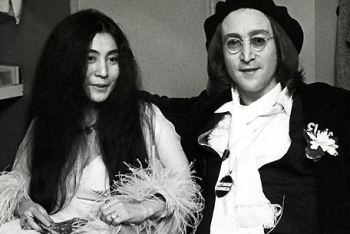 Goldman, assembling his data from the disaffected, was a boastful fantasist. John and Yoko were mutually competitive, sharp-tongued, often hurtful to one another. What Double Fantasy, and indeed their "Love Letter", celebrated was their gift for reconciliation (pictured above: in New York, 1974). Both missive and record are above all conciliatory in tone, reflecting down the years the import of Dan Richter's cover photo of John and Yoko under a tree for the 1970 Plastic Ono Band: we've made it through, we're going to carry on trying. Their wisest decision in 1980 was to answer the world's queries and concerns about them with music which was openly, pleasantly and unfashionably autobiographical.
Goldman, assembling his data from the disaffected, was a boastful fantasist. John and Yoko were mutually competitive, sharp-tongued, often hurtful to one another. What Double Fantasy, and indeed their "Love Letter", celebrated was their gift for reconciliation (pictured above: in New York, 1974). Both missive and record are above all conciliatory in tone, reflecting down the years the import of Dan Richter's cover photo of John and Yoko under a tree for the 1970 Plastic Ono Band: we've made it through, we're going to carry on trying. Their wisest decision in 1980 was to answer the world's queries and concerns about them with music which was openly, pleasantly and unfashionably autobiographical.
In 1980, was John Lennon beyond fashion? A legend for sure: but it was perhaps hard to know after the 1970s and his period of silence what, beyond his being the mouthiest, grittiest Beatle, the legend now represented. Since Beatles days, pop and rock had changed beyond recognition. Punk had shown it had no staying power, fun though a lot of it had been (it had also nearly destroyed the US record industry). Bob Dylan and Pink Floyd, even Elton John and David Bowie, had done their best work. Led Zeppelin had crash-landed with the death in September 1980 of their drummer John Bonham.
The Police, Talking Heads and Blondie were in the ascendant in the late 1970s: lean, pop-perfect, yet surely lacking that sunniness and those twists of magic The Beatles had purveyed, effortlessly, endlessly, just a short decade before. What Lennon would have made of Michael Jackson and Madonna in the 1980s is anyone's guess. He'd have enjoyed Prince's chutzpah. As it was, in his 40th year, he quite bravely just did his own thing. He always had. That Yoko Ono had always done so too was one reason why, beyond musical matters, they remained so intrigued by one another.
Mark Chapman wasn't just intrigued by John Lennon. He was obsessed by him. There's bitter irony in that at the very moment one of the most recognisable figures of the 20th century exits from history, one of the century's real nonentities has to enter it.
Mark David Chapman was born in Texas in 1955. He had a nomadic childhood which fostered a troubled adolescence: he was taking hallucinogenic drugs by his mid-teens. He was also a devoted Beatles fan. So were millions of American adolescents in the 1960s. His parents weren't at all taken with his long hair and interest in rock'n'roll, nor with his drug-use, if they knew about it. Perhaps they didn't, but that was normal for the era too.
At around the age of 17, he became a Jesus freak and renounced The Beatles, cutting his hair and giving up drugs. He left high school and went to a local college, but dropped out. He'd set his sights set on working for the YMCA and managed to get a job in the Beirut branch in Lebanon in 1975. When he arrived, civil war broke out, so he returned to Atlanta, where his parents lived. There, he fell in love and later enrolled in a Presbyterian college in Tennessee to train as a missionary, really, it seems, to impress the girl, with whom he fantasised about taking off to odd corners of the globe to spread the Lord's word.
Chapman couldn't keep up with the college's course. He dropped out (again) and took odd jobs in hospitals and trained as a security guard. Abandoned by his girlfriend, he fell apart mentally. His parents divorced and his mother moved to Hawaii; Chapman followed her, and in mid-1977 tried to commit suicide by attaching a hosepipe to the exhaust of his car and feeding it into the locked vehicle. When he failed in the attempt - as he'd failed in many things - and after a spell in hospital in Honolulu, he underwent psychiatric counselling and accepted a menial job in the same hospital unit.
In mid-1978, he did a round-the-world trip, visiting the YMCAs of various capitals, and returned healthier. By 1979, he was married to Gloria Abe, four years older and - peculiarly, now that we know Chapman - a Japanese-American. He was still working at the hospital, but also began to exhibit belligerent tendencies: a loathing for Christian Scientology; telling his wife she couldn't listen to the radio or read newspapers; an interest in firearms. He became sullen and overweight. He left the hospital in late 1979 and worked once more as a security guard.
Then, in October 1980, he read a magazine profile of John Lennon which was hostile in tone. The journalist, who'd been given no access, depicted Lennon as a 40-year-old recluse who watched television, sold cows, was run by his wife, made no music and sat on a fortune of “$150,000,000” (wrong, downwards, by $100,000,000). Chapman’s response to this, as to everything he now disapproved of, was: "What a phoney."
His plan wasn't without its hesitations, but it's clear that from some time in mid-October 1980 Chapman was certain he had to kill John Lennon. In Honolulu, he went to a gun shop and bought a five-shot revolver, a Charter Arms 38-calibre Special. On 29 October, he flew to Newark and checked in at New York's Waldorf Astoria for one night. Here, in fiction, in J D Salinger's The Catcher in the Rye, Holden Caulfield also spends one night. The novel was one of Chapman's obsessions. Caulfield's favourite word for anything he disapproves of is “phoney”...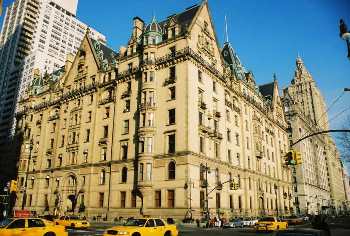 Chapman spent a few days in New York, based first at the YMCA on 224 East 47th Street, then at the Olcott Hotel, not far from the Dakota (pictured right), before flying to see his father's family down in Atlanta. He flew back up to New York at the beginning of November when he later confessed he was struggling with the spirits of "good" and "evil"; Chapman was pleased to find that the good ones, this time round, were winning him over from committing a horrific deed and he phoned Gloria in Hawaii to say he was flying home.
Chapman spent a few days in New York, based first at the YMCA on 224 East 47th Street, then at the Olcott Hotel, not far from the Dakota (pictured right), before flying to see his father's family down in Atlanta. He flew back up to New York at the beginning of November when he later confessed he was struggling with the spirits of "good" and "evil"; Chapman was pleased to find that the good ones, this time round, were winning him over from committing a horrific deed and he phoned Gloria in Hawaii to say he was flying home.
On 5 December, he flew back to New York, having told Gloria he had some more thinking to do. He checked into the YMCA on 63rd between Broadway and Central Park West. On Sunday 7 December, he changed to the Sheraton Centre Hotel on 52nd and Seventh Avenue, booking himself in for seven nights.
On his first day back in New York, Chapman dithered over visiting the Dakota. He finally got there that weekend. On the Sunday, he spotted Lennon with Yoko, broke rank with the usual crowd of gawpers and took some photos too close for Lennon’s comfort: Lennon chased him but Yoko told him to hold back. The next day, Chapman's resolve was altered and firm. Carrying copies of The Catcher in the Rye and of Double Fantasy, as well as his gun, he went to the Dakota at around midday and stood at the entrance with a few fans.
He stayed there all day. Inside, on the seventh floor, John and Yoko were finishing a photo session, the second of two, with Annie Leibovitz, cooperating with her for Rolling Stone. The pictures which emerged included the now unforgettable image of a naked John in a curled-up embrace of a fully dressed Yoko: a last combined visual message of intimacy to the world.
At five in the afternoon, Lennon emerged to go to his recording studio; he and Yoko were working on new material to follow up Double Fantasy. As Lennon stepped on to the sidewalk, Chapman proffered his copy of the record. Lennon took it and signed it "John Lennon 1980".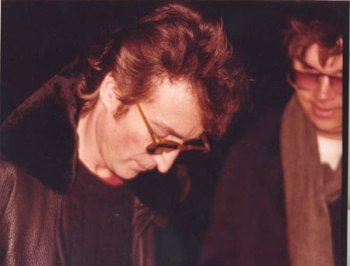 One of the fans present, Paul Goresh, who'd earlier struck up conversation with Chapman, snapped Lennon as he bent over the record, while Chapman - in glasses - stood a foot or so from his left shoulder, his hair dishevelled, his mouth in a half-smile. Once Lennon had gone, Chapman spoke of his triumph at having got Lennon's autograph. "They’ll never believe this in Hawaii!" Goresh left at around 8.30. Still Chapman waited and the doorman, a Cuban, thought little of it; loitering fans had long been part of the landscape at the Dakota entrance, day and night.
One of the fans present, Paul Goresh, who'd earlier struck up conversation with Chapman, snapped Lennon as he bent over the record, while Chapman - in glasses - stood a foot or so from his left shoulder, his hair dishevelled, his mouth in a half-smile. Once Lennon had gone, Chapman spoke of his triumph at having got Lennon's autograph. "They’ll never believe this in Hawaii!" Goresh left at around 8.30. Still Chapman waited and the doorman, a Cuban, thought little of it; loitering fans had long been part of the landscape at the Dakota entrance, day and night.
At 10.50, the Lennons' limousine pulled up. Yoko got out first and passed Chapman; he greeted her. Lennon then passed him and gave him a stare, and said nothing. Just inside the entrance, as Lennon retreated into the building, Chapman, a mere five feet away, said: "Mr Lennon?" As Lennon began to turn, he might or might not have seen Chapman’s marksman’s stance. Chapman fired five times. The first two bullets hit Lennon in the back and spun him round. Two of the last three bullets hit his neck and shoulder; one missed him altogether.
Lennon staggered up the steps into the Dakota lobby and collapsed, face down, on the floor, the cassettes and tape player he'd had in his hand falling with a clatter across the stone surface. Jay Hastings, the night porter, heard Yoko screaming "John’s been shot!" and was momentarily confused. But he had the presence of mind to press an emergency alarm under the reception desk which rang in the local 20th Precinct station. Hastings then laid a coat over Lennon. Yoko was hysterical. She stood over him, helpless. With blood gushing from his chest and upper torso, John managed to gurgle "I've been shot". When the police arrived, Chapman had dropped his gun and made no attempt to escape.
The Cuban doorman was yelling at him, asking him if he knew what he'd done.
"I’ve just shot John Lennon," Chapman replied.
A police car was commandeered to transport Lennon to Roosevelt Hospital and Yoko followed behind in a second. Chapman was handcuffed and bundled into a third. In the first car, Lennon remained just conscious enough to confirm to the officer that he knew who he was. By the time he was in the hospital's emergency room, he'd lost 80 per cent of his blood volume.
After immense efforts to resuscitate him, at 11.07pm John Lennon's life came to an end. He was 40 years and two months old precisely.
Afterword: 2001
John Lennon and Yoko Ono's 14 years of love and marriage is, in a sense, a never-ending story. Worldwide fascination in the life and work of Lennon alone is just one aspect of a perennially abundant Beatles-industry which shows no sign of drying up 30 years after the group ceased to exist.
Far from it, thirst for more information about the four, for more books, for more music - for more, indeed, of the same - and for yet more tributes to and explorations of one of pop culture's most alluring figures seems unquenchable. My hope was always that this book cast some new and objective light on a much-misunderstood strain of the whole remarkable saga: an odd but enduring relationship between a pop-musician and an artist which was like no other of its time.
Throughout 1997, as my deadlines were met and the book went to press, developments in the Beatles saga - call it continuing Beatles history - unfolded with (for me) frustrating abundance. It was Paul McCartney's year: a knighthood, a new album (Flaming Pie, after a phrase of Lennon's), a symphony (Standing Stone) and the first authorised biography, Many Years from Now by Barry Miles.
Miles (he's always been known as just this) had been one of my first interviewees when I was researching John and Yoko's meeting in 1966. So I was particularly interested to see his treatment of Lennon-Ono from the McCartney perspective: Miles's book was in effect Paul’s autobiography by proxy. Though containing little on the subject that couldn't be found elsewhere, the book had some nice touches:
"The Fab Four [Miles writes] had become the Fab Five without the other three ever being asked if they wanted a fifth Beatle. Yoko managed to irritate the other Beatles in a myriad of small ways. Paul: 'When she referred to The Beatles, she called them "Beatles": "Beatles" will do this. "Beatles" will do that. We said, The Beatles, actually, love.' "
Paul’s prominence in 1997 certainly led to widespread reassessment of a long-held view that only John's talent could explain The Beatles' genius. In his review of Miles's book, Charles Shaar Marray was on fighting form: "McCartney was a far more gifted musician, a more prolific and versatile composer than Lennon, and a far more eager and creative participant in the counter-culture of the Sixties." As if anticipating such paeans - and Paul's every move - Yoko, then in her 65th year, launched her own campaign.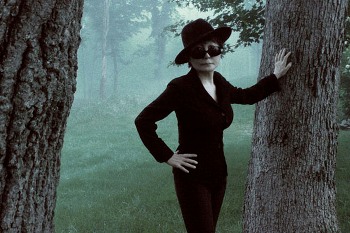 First up was a retrospective exhibition, Have You Seen the Horizon Lately?, at Oxford's Museum of Modern Art, making it her first show in England since the 1960s. It opened in autumn 1997 and aroused some curiosity but, as ever, critical scepticism: "Ono, it’s that woman again" ran the headline to William Feaver’s Observer review, about as concise a summary of her unfortunate reputation in Britain as could be found.
First up was a retrospective exhibition, Have You Seen the Horizon Lately?, at Oxford's Museum of Modern Art, making it her first show in England since the 1960s. It opened in autumn 1997 and aroused some curiosity but, as ever, critical scepticism: "Ono, it’s that woman again" ran the headline to William Feaver’s Observer review, about as concise a summary of her unfortunate reputation in Britain as could be found.
Around the same time, Parlophone released Lennon Legend, a Yoko-guided collection of John's "best songs". Especially intriguing was a long interview Yoko gave to the Daily Telegraph magazine, to promote both show and CD. Conducted by Michael Bracewell, it was a soft piece, punctuated by some glaring errors (Lennon-expert Jon Wiener's name spelt wrong, Yoko given two, not three husbands), and ventured praise of this most famous of widows - “an extremely eloquent feminist”, for example - which was at best courageous.
Most revealing of all in this unofficial war of words between Yoko and Paul was the article’s parting shot:
"'You must understand [said Yoko] that it was my husband who created that band, coined the name Beatles and was the lead singer.'" Oh yeah? one can hear Paul saying. As is now clear, McCartney was truly in at the start. John's friend Stu Sutcliffe was probably as responsible for the name. Paul took the lead vocal, from Hamburg days on, as often as John. As guardian-widow, Yoko has long cherished a more myth-laden version of events.
Over the next three years, there was no avoiding The Beatles. After a long fight against breast cancer, Linda McCartney died in April 1998. While not quite causing the national convulsions Princess Diana's death had eight months before, Linda's weirdly coalesced with the readiness of Blair's lachrymose Britain to mourn famous blondes. If John's murder 18 years previously had appalled the world, Linda's premature passing reminded us that normal mortality could touch the - now ageing - Beatles too. When George Harrison and his wife suffered a knife-attack by an intruder in their own house, one could have been forgiven for thinking that some kind of mummy's curse, going back as far as Brian Epstein's suicide - or even Sutcliffe's early death in 1962 - had dogged the Beatles in equal measure to their fame and fortune.
The next generation came into focus. Julian and Sean Lennon released albums, Photograph Smile and Into the Sun respectively, in the same month (May 1998), while Stella McCartney's high-profile forays into design and fashion became, for a time, a byword for Cool Britannia. John's uneven solo career was then given vast, some would argue superfluous, exposure in November 1998 on the John Lennon Anthology, a 4-CD compendium of noodling and studio outtakes; Q magazine's nomination less than a year later of Lennon as the "greatest recording artist of the 20th century" seemed to confirm that adulation of the legend was - amongst rock fans, at least - far from a spent force, even if his Q "No 1" position struck a slightly corny note.
In March 1999, I found myself interviewing over the phone a man called Hans Boskamp. It was the 30th anniversary of the first "Bed-In" at the Amsterdam Hilton (the second took place in Montreal in June 1969, when "Give Peace a Chance" was recorded). I was writing a piece for the Evening Standard. A former Dutch soccer star and one-time employee of EMI Holland, Boskamp had organised the Lennons' honeymoon, from the white Rolls Royce which drove them from Paris to Amsterdam to their exit from the Hilton seven days later. Boskamp had become a friend of John's and remembered the Hilton week vividly.
"John had his own reasons for doing it," said Boskamp. "He wanted to show the world how much he loved Yoko. And he was really against the war in Vietnam. They chose Amsterdam because it was the centre of flower power."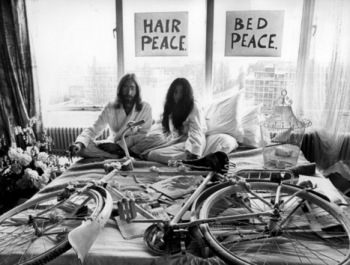 Boskamp, who was with them throughout the week, recalled that they were on a macrobiotic diet and drank no alcohol. They ordered goat's milk and insisted that everything be removed from the suite, except the bed.
Boskamp, who was with them throughout the week, recalled that they were on a macrobiotic diet and drank no alcohol. They ordered goat's milk and insisted that everything be removed from the suite, except the bed.
"They giggled a lot, played tapes and records, and when they were alone, Yoko wanted to sing. She couldn't sing and it was dreadful." And drugs? "There were no hard drugs, but Hilton staff got hash and grass for them without any difficulty."
John also discovered, from the papers, that Northern Songs, The Beatles’ back-catalogue of some 160 songs, was to be sold to ATV: news to him and he was furious (Michael Jackson eventually bought the lot in the mid-1980s; the ATV purchase was perhaps, also, yet another incentive for John, radically realigning his priorities, to abandon the group altogether). In the hotel car-park below, meanwhile, thousands of fans could see the signs, "Bed Peace" and "Hair Peace", stuck to the windows of the seventh-floor suite (pictured above left).
"They cried and shouted all day, every day," said Boskamp.
And so The Beatles books went on. The best one of 1999 was Debbie Geller’s biography of Brian Epstein. The best one of 2000 was an astounding production: the 368-page Beatles Anthology, a complete and comprehensive chronology of the story told in the words of the four - John's resurrected from interviews and archives across the world - with additional comments from producer George Martin (the true and only fifth Beatle), press chief Derek Taylor, roadie Neil Aspinall and others. Since John Lennon und Yoko Ono - zwei Rebellen, eine Poplegende appeared, two questions have regularly been asked of me: first, did I meet Yoko, and if not, why not; second, had John lived, would he and Paul, in my view, have got back together?
Since John Lennon und Yoko Ono - zwei Rebellen, eine Poplegende appeared, two questions have regularly been asked of me: first, did I meet Yoko, and if not, why not; second, had John lived, would he and Paul, in my view, have got back together?
Answer to the first: no, though I tried. I and my German publishers sent her a manuscript but we never heard her verdict. I also attempted, twice, to secure an interview, without success. Opinions as to her early appearances in John's life - gathered from a wide range of sources - are, I believe, based on sound testimony. In depicting the latter part of her life with John, I was at pains to emphasise her strength of character and resourcefulness.
Answer to the second: again, no. But they'd possibly have jammed together somewhere, at some point, possibly even with the other two. They'd not have written together again, which is fine. What, from 1962-69, Lennon and McCartney bequeathed to the world is enough to fill 4,000 lifetimes and, no doubt, inspire several more generations of books.
Listening
In the 10 years since that note was written for the Rowohlt paperback (pictured above), the Beatles story has both grown and shrunk. George Harrison, Derek Taylor and Neill Aspinall have died. Paul McCartney has remarried, become a father for the fourth time and divorced. McCartney is always busy: writing, publishing, painting, playing, dating. Ringo Starr has performed a bit but most of us are more comfortable with his celebrity than his music.
There have been more books, another monster-selling album, 1, programmes and broadcasts, computer games, interviews with Paul - mainly - and an odd, touring show with Cirque du Soleil, called Love, a sort of acrobatic Beatles medley-in-motion, with arrangements by George Martin. Four years ago, I gave, for Christmas, Love's soundtrack to my Beatles-loving brother - whom I taught, when he was five, to sing “Carry That Weight” (in the bath, for some reason): after one listen, he threw the CD in the bin. Beatles simulacra are invariably painful. This low has been remedied by his youngest son, who has a beautiful voice, falling in love with the real Beatles at the age my passion erupted. He'll be singing their songs for the rest of his life. I still do.
One correction to the above: I did in fact meet Yoko Ono, just once, very shortly after (with some irony) delivering the Afterword to Rowohlt. She was installing a small show in a Berlin gallery. I was told she’d be there, so I went along to introduce myself and tell her about the book. My hope was to launch it in English, with her cooperation.
She was friendly and asked me to send the manuscript to her. Our exchange lasted a minute. After I’d posted the MS across the Atlantic, it bounced back from the Dakota some weeks later, ending up at a “return-to-sender ” address in London I'd provided. When I tried one last time - via digital communication - to get her to read it, I was asked to send an MS to a law firm in New York, so I dropped the project altogether.
On Wednesday's anniversary, I’ll take a day off, pop open a bottle or two, and listen to my favourite Beatles albums: the four last great ones (excluding, therefore, Magical Mystery Tour and Yellow Submarine), which I still have on vinyl. If you want to re-experience the group - to reach something as vital to you as your own bloodstream - and forget how awful that December day was 30 years ago, there's no more essential route back. I might even try on my Sgt. Pepper cut-out moustache.
- Watch The Day John Lennon Died on ITV Player
- Find The Beatles on Amazon.
- Find John Lennon on theartsdesk
- Read Part 1 of John Lennon's Love and Death









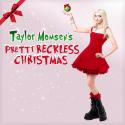



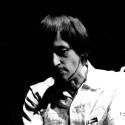
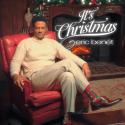
Add comment